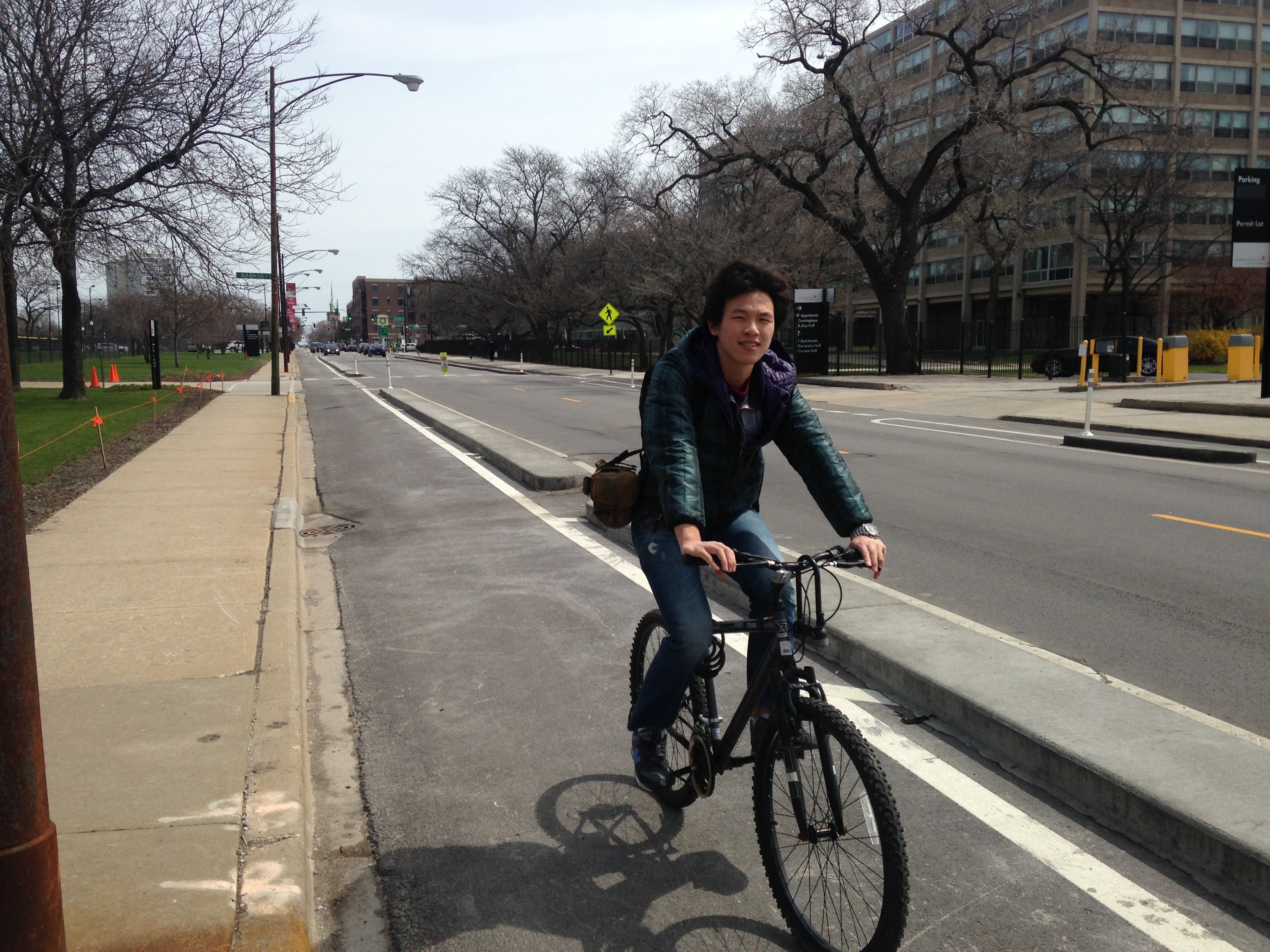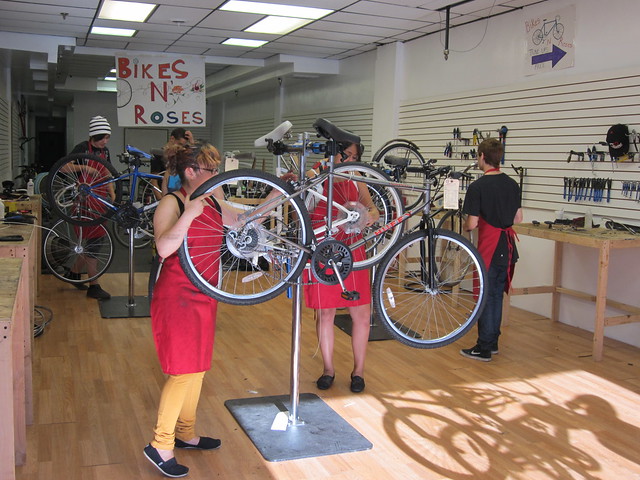City Begins Work on Next 50 Miles of Bikeways, Funds Bikes N’ Roses
5:45 PM CDT on April 11, 2016
Today at a ribbon cutting for curb-protected bike lanes on 31st Street by the Illinois Institute of Technology, Mayor Emanuel and transportation commissioner Rebekah Scheinfeld elaborated on the city’s previously announced plan to build 50 more miles of bikeways by 2019.
This represents a slower pace of installation than the city’s previous achievement of installing 103 miles of buffered and protected bike lanes in about 4.5 years, starting in 2011. However, while 83.5 miles of those lanes were buffered, merely paint on the road, it’s possible that a higher percentage of the new bikeways will feature better protection from car traffic.
Scheinfeld say the upcoming 50 miles will include many so-called “better bike lanes,” including off-street paths, new “neighborhood greenway” routes on traffic-calmed residential streets, concrete-protected lanes, and safety improvements at key intersections.
Cortland/Ashland in Bucktown, near the eastern terminus of the Bloomingdale Trail, and Logan/Western in Logan Square spring to mind as intersections with high bike traffic that also are scary junctions with high crash rates – hopefully these are on the shortlist for improvements.
“We’ve made progress installing protected bike lanes in neighborhoods across Chicago, making it easier and safer for everyone – no matter their age or ability – to get around on a bicycle,” Emanuel said. “Today, we’re building on that progress and looking to the future.”
Today’s event highlighted the new roughly half-mile, seven-foot-wide bikeway on 31st between State and LaSalle. It’s a mix of buffered lanes, curbside lanes protected by plastic posts, and concrete-protected lanes, with the majority of the concrete near the college campus. After I took a quick spin on the facility my impression is that it’s a well-designed bikeway, although we’ll have to see how it holds up in rainy and snowy weather – which has been an issue with the city’s other major curb-protected bikeway on Clybourn.
This year the city plans to install nine more miles of “better bikeways,” up to 18 more bikes of other (“worse”?) bikeways, and restripe up to 20 miles of existing bike lanes. “As we focus on building better bike lanes, CDOT will continue to strengthen and improve the connectivity of Chicago’s existing bike network so that bicycling continues to grow and serve as a safe and enjoyable way to travel around our city,” said Scheinfeld.
The commissioner added that protected bike lanes seem to be effective in reducing crashes, partly due to their traffic calming effect. For example, CDOT reports that, since the 55th Street protected bike lanes were installed on 55th Street in Hyde Park in 2012, overall crashes have dropped by 32 percent. CDOT recently released the new bike lane report 2015 Bikeways: Year in Review, which has more info on their findings. I’ll provide an analysis of that document tomorrow.
The Active Transportation previously put out a call for the city to install 100 miles of better bikeways by 2020, but director Ron Burke says OK with the city’s current, more modest mileage goal of 50 miles, although he still hopes CDOT will wind up installing more.
“We recognize the importance of quality as well as quantity,” he said. “These curb-protected lanes are obviously a huge step in making facilities that the average person will feel comfortable riding in and that will last. The plastic posts are getting knocked down all the time, so this is part of the evolution of the bike network.”
Prior to 2011, the lion’s share of bikeways went to neighborhoods with a high existing level of cycling and bike advocacy, which favored wealthier North Side neighborhoods, although CDOT says 60 percent of the bike lanes installed under Emanuel have gone to the South and West Sides.
In an effort to increase bikeway equity in the future, CDOT has been hosting a series of community meetings on the West and South Sides to get input on which streets should be prioritized for new bikeways. Unfortunately, a total of only five West Side residents showed up for the first two meetings in Austin and East Garfield Park.
CDOT is hosting the two South Side meetings this week. The first takes place tonight at Vodak-East Side Public Library, 3710 E. 106th Street, from 5:30-7:30 p.m. The second is Tuesday at the Historic Pullman Foundation at 11141 S. Cottage Grove Avenue, from 5:30-7:30 p.m. Hopefully there will be a better turnout for these hearings.
Slow Roll Chicago cofounder Jamal Julien says the meetings are a step in the right direction towards improving bike equity. “We hope to keep working with the city to push for additional bike infrastructure and resources that are distributed equally,” he said. “When you have more walkable, bikeable communities, you have more liveable and safe communities.”
In other bike news, yesterday Emanuel announced that the city will provide $154,000 in funding to reopen the Belmont-Cragin headquarters of the Bike N’ Roses youth education center and community bike shop, which the city says will fund 65 employment opportunities for low-income teens. Bikes N’ Roses previously shut its doors after Governor Bruce Rauner cut state funding to the center and the Catholic Campaign for Human development pulled grants to the center’s parent organization the Albany Park Neighborhood Council due to its support for LGBT rights.
Burke applauded the city’s decision to fund the program. “We love Bikes N’ Roses,” he said. “Community bike shops like them are crucial to the fabric of the neighborhoods they serve, and they help cultivate the next generation of bike advocates.”
This post is made possible by a grant from the Illinois Bicycle Lawyers at Keating Law Offices, P.C., a Chicago, Illinois law firm committed to representing pedestrians and cyclists. The content is Streetsblog Chicago's own, and Keating Law Offices neither endorses the content nor exercises any editorial control.
In addition to editing Streetsblog Chicago, John writes about transportation and other topics for additional local publications. A Chicagoan since 1989, he enjoys exploring the city on foot, bike, bus, and 'L' train.
Stay in touch
Sign up for our free newsletter
More from Streetsblog Chicago
Today’s Headlines for Thursday, April 26
The de-facto ban on riverwalk biking is back. What should we do about it?
In the short term, new signage is needed to designate legal areas for cycling on the path. In the long term CDOT should build the proposed Wacker Drive protected bike lane.







